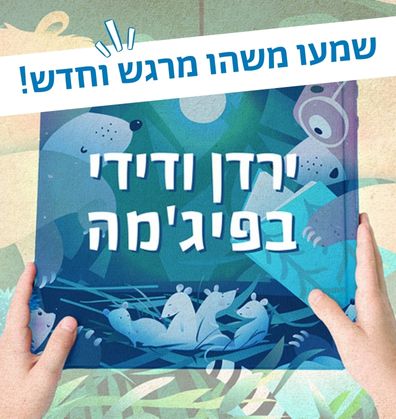טֶבַע וּסְבִיבָה
שמירת סביבה
כמה נעים וטוב להביט ולהלך בסביבה ירוקה, שופעת ונקייה! שמירת הסביבה היא ערך חשוב המסייע לנו לשפר ולטפח את העולם בו אנו חיים. ספרים על שמירת הסביבה ובהם הצעות לפעילויות ולחוויות מרחיבות דעת, מעצימים את ההבנה שעלינו האחריות לשמור על הטבע, ומהווים שביל נפלא במסע להגברת המודעות הסביבתית, ובפיתוח הקשר והזיקה לטבע.
סְּפָרִים
Book-Related Family Activities

Family Reading Advice
There are lots of ways to enjoy a book – after reading it, you can go back and “read the illustrations”: Which objects can you identify? And which plants?

Every Excursion has its Own Story
You can discuss with your children and remember family trips together – Where did you travel? Did anyone get upset on the trip and you helped them? Do you also have a story about an item that got lost while you were on a trip? Or perhaps you also helped to protect the environment?

Searching in the Water
This book can inspire you to play an entertaining quest – fill a large bowl or bucket with water, then add soap so that the water will not be clear and transparent. Now slip in all sorts of small objects: A teaspoon, bottlecap, pebble, coin, or any other item. Ask your children to help you find the “lost” items in the water.

What is it like to have Blurred vision?
If you wear glasses, you know how it feels. Now you can let the rest of your family experience what it feels like: Place baking paper or a thin, light-colored fabric on your eyes, and try to see through it. Look around and at one another – what is different? How do you feel?
A game of “Find me!”
The main characters in this book are a hedgehog, rabbit and mouse. But other animals also appear in the illustrations –
Can you find them?
How many animals have you found?
“Did you find me in the illustrations?”
Discussion
Do you, much like the pine tree, feel lonely sometimes? Have you ever seen a boy or girl who seemed a little lonely? You may want to discuss this feeling of “being all alone” and what we could do when we – or those around us – feel this way.
Some information on pine trees
The Jerusalem Pine (more commonly known in English as the Aleppo Pine) is the species of pine trees that grows in Israel. It is highly prevalent in the Carmel and Judea Mountains areas. As the Jewish community, the Yishuv, grew, it began to plant large pine tree forests in the Land of Israel. The pine tree contains resin, and in springtime, its branches are densely filled with pinecones. Would you like to learn more about the pine tree? Feel free to look for images and additional information online.
The next chapter
What will happen once the trees grow and a forest is created? Will they be friends with the pine tree? Will other friends come and visit? And what will the children do in the new forest? – You may enjoy discussing the next chapter of the book, acting it out, or drawing it together.
A game – Who am I?
Am I the wind blowing? Or the falling rain? Perhaps a leaping rabbit? You could play a form of charades by taking turns miming one of the characters in the book, and having the others try to guess which one you’ve chosen.
How to adopt a tree
How about picking a tree in your area and taking care of it? You could clean around it, place a mat under it, and observe the small animals that use it as part of their habitat. If you look carefully, you may even catch it smiling.
Discussing – What about our world?
What is your responsibility, as parents and children, for your friends, family, and environment? Which roles do you play within the family, and which additional roles would you like to assume responsibility for in order to help others and your surroundings? Perhaps you could discuss and make suggestions that would help your family in their day-to-day, such as: sweeping the porch; checking in with a sick friend; recycling bottles, paper, and bio-degradable materials; set the table for dinner, or tightly close leaking faucets.
Doing some arts & crafts – A family tree
Cut out some paper leaves. Each family member gets some leaves, and writes suggestions for actions that would be considerate of other members of the family, such as: leaving enough warm water for others to shower; feeding your pet hamsters, or saying ‘good morning’ with a smile. Make your tree in painting form or some other artform using recycled materials or tree branches you have collected, and attach all the leaves to it.
You could try to put your ideas to practice. How about deciding to try out one suggestion each day? And if it doesn’t go too well for you, don’t worry, tomorrow is another day…
Suggestions and examples can be found on the PJLibrary Pinterest page – The Juice Tree.
Playing – How can we pass leaves round?
The villagers must cooperate for the tree to grow more leaves. Games are a delightful way of working together as a family: cut out a paper leaf, and stand in a row. Ready? Here we go!
Pass the leaf round from one player to the next without touching it with your hands. If any of you struggle, help by giving them advice and cheering them on. By way of celebrating when the game is over, enjoy your favorite beverage.
Raise your glass to your cooperation, and the many collaborations still to come!
Continuing with the story
The book ends with Mr. Milly’s silence. He smiles, and helps water the tree. And then what happens? You could try to continue the story from this point: What was Mr. Milly thinking while he smiled quietly? What happened to the juice tree and the villagers? Did they keep on picking a single leaf? Or did something surprising happen down the line?
Proposed Family Activities:
- How about packing this book along with some refreshments and a blanket, finding a beloved tree in nature, and reading the story there together. Afterwards, you may enjoy collecting pine cones, tree bark, leaves, and more. When you return home, you can use them to make a piece of artwork together.
- You may want to snuggle up and look at the magnificent illustrations closely. Can your child identify some familiar trees by their illustration?
- After you finish reading the story, you may want to ask your child what they think Giora will do now, and what will happen to the trees. Perhaps you would enjoy writing up a creative follow-up to the story told, and illustrating it.
- Baobab, loquat, Tamarisk, Pecan… Giora knows every tree by name. what kinds of trees grow near your home? How can you identify them? How can you tell them apart? You may want to take go tree-spotting together, learn about the trees you see, and make an illustrated tree guide together.
- How about taking a walk near your home? Are there any open spaces or dilapidated courtyards nearby? Perhaps you and some friends could clean them up, and make them look nicer. You could even plant a community garden with your neighbors.
- Do you know any other stories or poems about trees (like Zuta and the Apple Tree by Orit Raz, What’s it like to be a Tree? By Datia Ben Dor, The Abba Tree by Devora Busheri, What Does it Take by Gianni Rodari)? You may want to look for them at home or in the library, and read them together.
This is the last book your child will receive from PJ Library this year. We hope you have enjoyed reading, discussing, and doing the activities together. We wish you a summer full of wonderful experiences and story times. See you next year!
Magic drawings.
Magic drawings. It is not always easy to start drawing on a blank page. You may enjoy making magic drawings with your child: use different crayons to color an entire white sheet of paper in various colors, then add another layer of black crayon on top of it. Now, using a coin or bamboo skewer, draw anything you like on the black coat of paint, and whatever you draw will come out multicolored.
Adding good.
Adding good. What is missing from the world around you? You could take a look around your home with your child, or around your street, kindergarten, neighbors’ and friends’ houses: what could you do to make the world a better place? Perhaps you could decide to decorate the garbage can in your building together, help a neighbor with a task they find difficult, or simply try to use words like “thankyou” and “please” more often, and smile at the people you meet.
Rhyming and rhymes.
Rhyming and rhymes. Your child could actively participate in the reading experience with the help of the rhymes. In time, they may even be able to “read” the book on their own. Do you like wordplay? You may enjoy making up some rhymes of your own.
Color hunting
Color hunting. The world is filled with color, and you may want to take a walk around the neighborhood to discover them. Take a white sheet of paper along with you, and some crayons, and go hunt colors. Each time you spot something, draw a circle of the same color on your sheet of paper: for blue skies, draw a blue circle; for a red road sign, draw a red circle; and so on. At the end of your walk, you will have a beautiful, colorful sheet of paper.
Drawing together.
Drawing together. You could also take a blank sheet of paper and some crayons, and make a joint drawing: parents start out by drawing a line, dot, or patch of color, and their child adds another detail, followed by the parent, and so on. By the end of this exercise, you will get a shared drawing to which each of you has contributed their share.
I have created a critter
“I have created a critter”. In the world created by Paul Kor there are purple waves, pink stars, and imaginary critters. You could also create imaginary creatures with your child using playdough or clay. You may want to decide what color your critter will be together, how many eyes it will have, and what it will be capable of doing.
Proposed Family Activities:
- You may enjoy looking at the illustrations together. The bee appears on every page (sometimes it is hidden). You could try to follow it, and tell the story from her perspective. Can you identify the various gifts that the Queen of Sheba brings King Solomon? What kinds of gifts can one bring a king? Does he need them?
- You may want to look for the illustration in which King Solomon lets the bee go. Perhaps you could ask your child: Why is he laughing? Does he truly believe a small bee could ever help him?
- You could pretend to be bees yourselves. Let your child be the bee, and pretend to be its fellow bee. Fly together and buzz to one another – your child will tell you all about the bee’s encounter with the king, and you can react to the story.
- “Wise is he who learns from all men”: you may want to ask your child what makes one wise, what wisdom is, and what King Solomon learned from the little bee. Perhaps you could tell your child something they did not know, and ask them to enlighten you with their knowledge!
- Perhaps you could discuss the skills and contributions made by each member of your family. Together, try to remember times when your child was particularly helpful. Even the youngest members have their “hour”, in which they help and contribute to the greater good.
- The Queen of Sheba came to Jerusalem to ask King Solomon riddles and test his wisdom. Do you know any riddles? You can put them to your child, or invent some new ones together.
- This story is based on a tale about King Solomon, “the wisest man who ever lived”. Do you know any other stories about King Solomon? Perhaps you could share them with your child.
Family Activities
“… the tiger understood that a smile would appear on his face each time he felt happy”
Take your child for a walk outdoors and enjoy the nature that surrounds you. Like the tiger, you too can play with crushed leaves, listen to birds chirping and climb up hills.
What makes you and your child smile? You can play “the smiling game” together: Pass a ball between you. Each time one of you tosses or rolls the ball to the other, mention something that makes you happy. Don’t forget to smile throughout the game!
Where is our child and his or her smile? You can play hide-and-go-seek throughout the house, looking for each other’s smile.
The tiger looked into a puddle and discovered his smile right under his nose. In our homes we don’t have puddles but we do have mirrors! Your child can discover his or her smile in the mirror, and make funny faces at his reflection.
Song and dance are natural ways of expressing our happiness. You can sing and dance with your child, even without a special reason. Think of songs that are especially appropriate, such as “If you’re happy and you know it…”.
At the end of the story the tiger jumps with joy. If the story had continued, he might have even burst into laughter. Do you want to laugh? Here’s a funny way to start: Everyone in the family lies down on the carpet, with one person’s head resting on another’s belly. One member of the family starts to giggle, his or her tummy trembles, and soon you’ll all see how contagious the laughter becomes!
The author and illustrator Katherine Rayner loves the animals she depicts in her books. Our story is accompanied by special drawings. Go through the book with your child, noting how the tiger looks when he has lost his smile, and how he appears when he finds it in the puddle.
“Augustus and his Smile” is the first Sifriyat Pijama book of the year. Reading books together as a family is one way to bring joy and happiness into the home, and can put a smile on everyone’s faces. Enjoy!
Family Activities:
- The adults in the story are doubtful that the carrot will grow. You can discuss this with your children and share your own experiences. You may ask: Why do the adults had trouble believing that the carrot would grow? When you read the story, did your children think the carrot would grow? Did you ever have someone not believe you? How do you feel when others doubt things of which you are certain?
- The boy in the story does not speak, and we can only imagine what he is thinking and feeling as the others express their skepticism. If the boy could talk, how do you think he would respond? Together with your child you can select dolls to represent the boy, his parents and his brother. As you re-read the story, use the dolls to create a dialogue between the boy and his
- At the end of the story, the boy transports the carrot in a wheelbarrow. What do you think happens next? Where is he taking the carrot? How do the others respond when they see the giant carrot, and what does the boy do with it?
- The carrot grows under the ground, and not on the shelves of the grocery store! You can visit the supermarket or neighborhood grocery and take note of the various fruits and vegetables. What grows from a seed, like the carrot? What grows under the soil, and what blossoms on a tree? Which foods can be prepared from each fruit and vegetable, and what do we like in particular?
- Crockett Johnson’s illustrations depict the story that occurs above ground. You can suggest to your children that they draw a parallel story of the carrot, page after page, reflecting the process under the soil. In the end you will have two booklets illustrating the story “The Carrot Seed”: one of the boy and his family, and the other – the story of the
- There are many delicious foods that can be prepared with carrots: carrot juice, carrot soup, carrot salad, carrot bread and more! Here is an easy recipe for sweet and delicious carrot salad: Ask your children to help peel and grate a few carrots into a bowl. Add a bit of lemon juice, sugar and a handful of raisins and mix together. You can serve your carrot salad to the whole family. Bon Appetite!
- “The Carrot Seed” demonstrates the great amount of patience and perseverance needed to grow vegetables. These traits are necessary to achieve many goals in life. You can share a personal story with your child of something you achieved with great effort and after a long wait, and tell them about the sense of satisfaction this
Family Activities:
- Look closely at the illustrations together with your child. Did you take note of the same things? Did you discover anything surprising or humorous in the pictures? You may ask your children if they recognize all the objects in the book, and explain those things that they do not know. Take a closer look: Some of the illustrations are made from photographs; others are created with torn pieces of paper or fabric. You can flip through the pages and look for all the things that are made of wood. Did you notice how the letters are made?
- Take note of the book’s cover. Did you notice the flower that is sprouting from the wooden table? Which came first, the flower or the table? As a way to emphasize nature’s cycle, try reading the book backwards, from end to beginning.
- Which trees grow near your home? You can go out together for a walk and collect twigs and special leaves. Back home, you can glue your treasures onto a clean piece of paper and create a picture.
- The blessing of the trees reminds us to stop and enjoy nature. You can talk about the plants and trees that you know – their names and their characteristics. Which trees do you find beautiful? Which trees produce fruit and which do not? You can discuss the many ways we benefit from different trees.
- Together with your children, you can make your own What Does It Take… book. Invite your children to cut or rip pictures from old magazines. Then glue the torn pictures onto pieces of white paper, punch holes in the side of the pages and tie them together with a shoestring. Does your book have pictures of flowers and trees as well?
- Do your children know the origins of the food they eat, the clothes they wear, their books and toys? It is important to encourage questions on the source and production process of everyday objects. Even when we do not have all the answers, the act of wondering about this expands the children’s knowledge base and increases everyone’s appreciation and gratitude for our world.
- You can play a family game of “What is made of…?” One person thinks of an object in the home (furniture, kitchenware, toys…) and announces, “I’m thinking of something that’s made of…”, and the others try to guess the object. Be sure to take turns so everyone has a chance to ask the questions and provide the answers.
looking at the illustrations together
You may enjoy looking at the illustrations together and asking your child to tell the story in their own words. How do the various animals respond to the rain? How has the illustrator chosen to depict the rain and wind? We don’t know what Rabbi Hanina Ben Dossa looked like, but we can imagine how he lived his life in those days, and what the Galilean landscape was like. Try to look for signs of the place and time in the various pictures.
dress up as the different characters and act out
You may want to dress up as the different characters and act out the story to your friends and family. Using facial expressions and hand gestures, you could imagine how grateful the birds and animals were for the rain, and how sorry they were when it stopped.
discuss the things that did not exist
Following the story, perhaps you would like to discuss the things that did not exist during the time of the Talmud, and make our winters easier, such as umbrellas, electric heating, and so on.
Do you like the rain
Do you like the rain and look forward to it? Perhaps you would like to discuss fun things to do in winter, and how the rain affects the flora and fauna. Have you ever had to cancel a planned trip or outdoor activity because of the weather? You may want to remind each other of such incidents.
"The whole world is at ease but Hanina is in distress?"
“The whole world is at ease but Hanina is in distress?”: What makes us happy does not necessarily make others happy. You may want to discuss clashing desires within the family, and the ways to cope with them.
ideas for rainy day playtime and entertainment
Perhaps you would enjoy making a box of ideas for rainy day playtime and entertainment. Ask your child to decorate an empty shoebox. In it you can keep little surprises such as stickers, crayons, marbles, soap bubble dispensers, and colorful notes with ideas for family activities on rainy days (word puzzles, reading, cooking and baking, and so on). Stow the box away, and only open it when it rains outside!
Who was Rabbi Hanina Ben Dossa?
Rabbi Hanina Ben Dossa was a Tanna – a Mishnaic sage – who lived in the Galilee some 2000 years ago. He was a wonderful man, and many tales describe his special qualities. Ruth Calderon, the author, based this story of Rabbi Hanina and the rain on the following short excerpt found on page 24b of the tractate of Taanit in the Babylonian Talmud:
חנינא בן דוסא הוה קא אזיל באורחא
Rabbi Hanina Ben Dossa was journeying on the road
אתא מיטרא
it began to rain
אמר לפניו: רבונו של עולם, כל העולם כולו בנחת וחנינא בצער?
He exclaimed: Master of the Universe, the whole world is at ease, but Hanina is in distress?
פסק מיטרא
the rain ceased
כי מטא לביתיה
When he reached home
אמר לפניו: רבונו של עולם! כל העולם בצער וחנינא בנחת?
he exclaimed: Master of the Universe, the whole world is in distress and Hanina is at ease?
אתא מיטרא
It began to rain
Proposed Family Activities
- Your child might enjoy telling you the story according to the series of illustrations. They might want to pick a certain character, and look for it in each illustration throughout the book: Who did they choose? Why that character? What does it like to do in the field?
- You may want to share stories about the changes you have undergone since childhood with your child. Has a childhood puddle turned into a highway? What happened to the field you used to play in as children? Perhaps you would like to look at old photographs together, and compare them to today.
- Is your neighborhood, like the one in the story, expanding and undergoing changes? You may want to visit a construction site together, peek over the fence, and look for tractors and cranes. If tall buildings are being built there, you could try counting the stories together. Or perhaps you’d like to imagine the flowers the new tenants will plant in their gardens, and who they would be. Maybe new friends will move in there?
- Have you ever left a familiar, well-loved place behind? Did the change make you happy? Try to remember and share with your child: How did you feel before the change, and how did you feel once you had gotten used to it?
- The book describes the flowers and greenery typical for each season. You could take a walk with your child, observe nature, and look for flowers. Which flowers have you come across? What color are they? Do you know names of wild flowers? You could also take a picture of yourself with pretty flowers. Have you found a dandelion? Try blowing on it. Have you managed to blow its white “hairs” off and see them fall to the ground like snow?

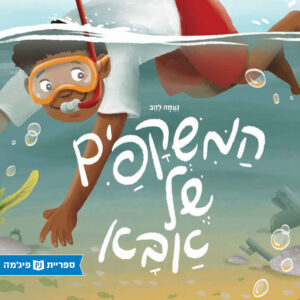 Aba’s Glasses
Aba’s Glasses 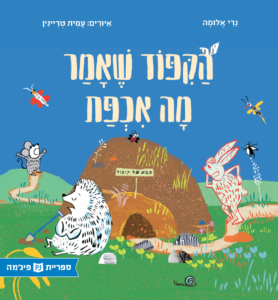 The Hedgehog Who Said: Who Cares?
The Hedgehog Who Said: Who Cares? 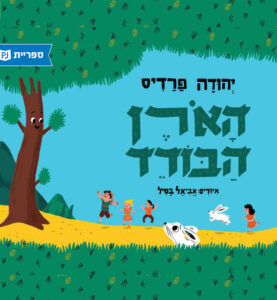 The Lonely Pine Tree
The Lonely Pine Tree 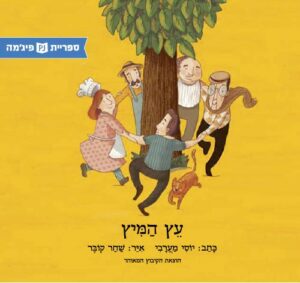 The Juice Tree
The Juice Tree 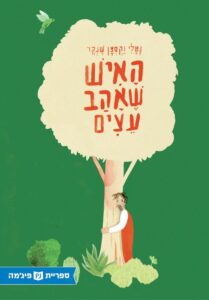 The Man who Loved Trees
The Man who Loved Trees 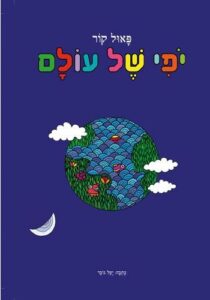 Beautiful World
Beautiful World 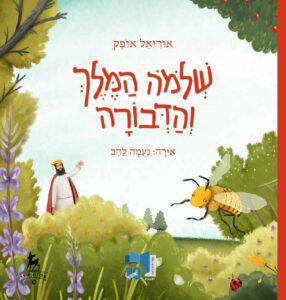 King Solomon and the Bee
King Solomon and the Bee 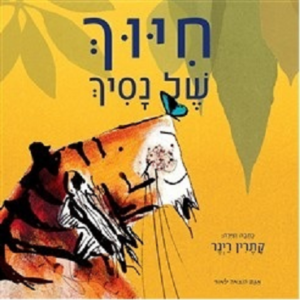 Augustus and his Smile (Hebrew title: Prince’s Smile)
Augustus and his Smile (Hebrew title: Prince’s Smile) 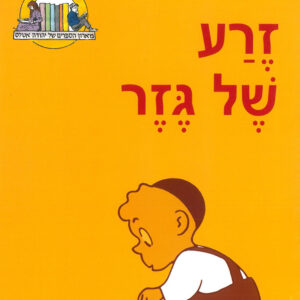 The Carrot Seed
The Carrot Seed 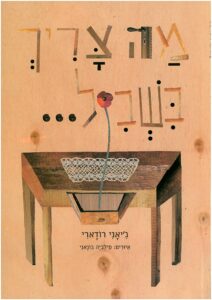 What Does It Take?
What Does It Take? 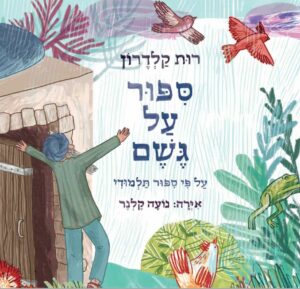 A Story about Rain
A Story about Rain 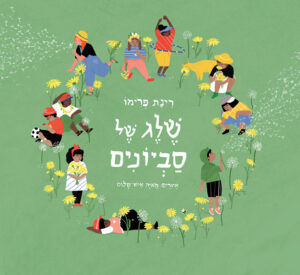 Snow of Dandelions
Snow of Dandelions 


